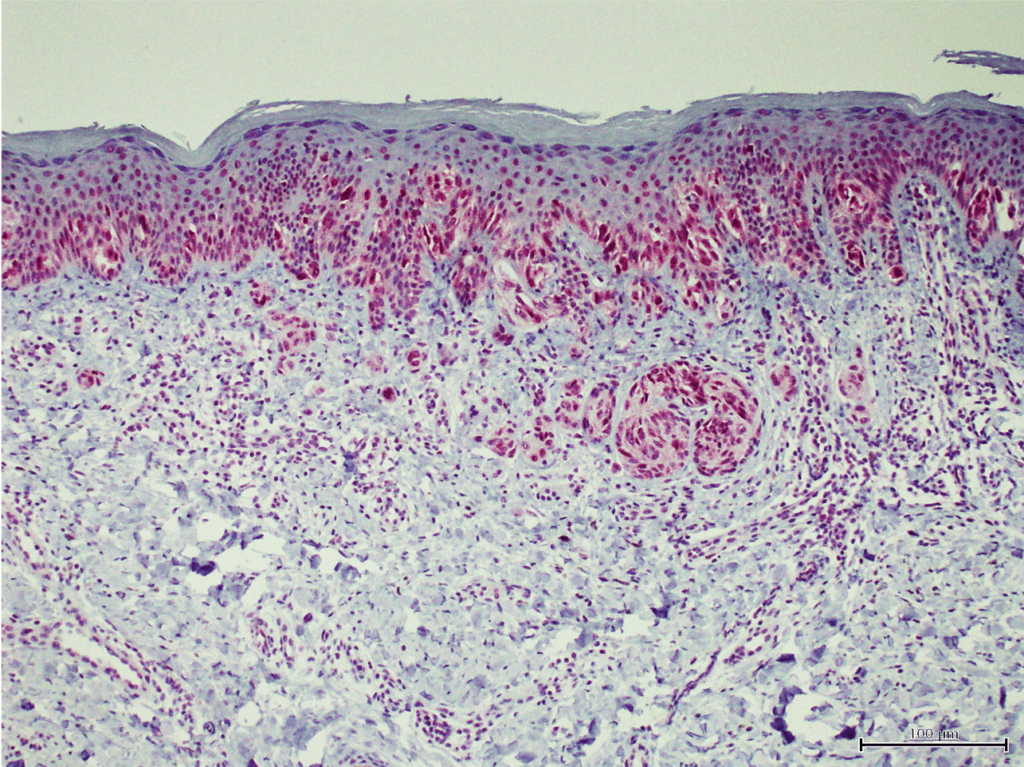Description
PRAME (PReferentially expressed Antigen in MElanoma) is a tumor-associated antigen that is preferentially expressed on the cell nuclei of neoplastic melanocytes. The new anti-PRAME antibody is therefore a useful test supplement in situations where antibodies against Hmb-45, Melan A and SOX10 do not provide sufficient information to distinguish benign from malignant melanocytic lesions. In addition, it can also be a valuable marker for assessing the margin of known PRAME-positive melanomas. Sebaceous gland lobules can be used as an internal positive control. Recent publications showed that diffuse nuclear immunoreactivity for PRAME can be found in 83.2% of primary and 87% of metastatic melanomas.Diffuse PRAME expression is found among all melanoma subtypes, 92.5% in superficial spreading melanomas, 94.4% in acral melanomas. 86.4% of cutaneous melanocytic nevi showed completely negative PRAME staining. PRAME is a cancer testis antigen (CTA) that was identified by analyzing the specificity of tumor-reactive T cell clones derived from a patient with metastatic cutaneous melanoma that showed no expression in normal healthy tissues except testis, ovaries, placenta, adrenal glands, and endometrium. PRAME is expressed not only by melanomas, but also by various non-melanocytic neoplasms including non-small cell lung cancer (NSCLC), breast carcinoma, renal carcinoma, ovarian carcinoma, leukemia, synovial sarcoma, and myxoid liposarcoma. Due to its expression profile, PRAME is a very attractive marker for immunotherapy. A number of clinical trials are currently underway attempting to use CTAs, including PRAME, for cancer treatment. In addition to interest as a treatment target for patients with metastatic melanoma, PRAME has been identified as an important biomarker for metastatic risk in class 1 uveal melanoma.
References
[1] Ikeda H et al. (1997). Immunity. 6(2):199-208.
[2] Lezcano C et al. (2018). At J Surg Pathol. 42(11):1456-1465.
[3] Nettersheim D et al. (2016). Br J Cancer. 115(4):454-464.
[4] Gassenmaier M et al. (2021). Cancers (Basel). 13(15):3864.
[5] Lozachmeur C et al. (2022). Int Clin Img and Med Rew. 2(4): 1088.
[6] Kunc M et al. (2023). Histopathology. 83(1):3-14.
[7] Koch ETA et al. (2023). Int J Mol Sci. 24(7):6388.
______________________________________________________________________________________________________________________________
Specifications
Application: IHC (FFPE)
Host: Rabbit
Subclass: IgG
Immunogen: Synthetic peptide from human PRAME
Dilution range: 1:50 – 1:100
Cellular location: Cell nucleus
Control: Testis, Melanoma
NordiQC evaluation: Optimal staining result in NordiQC Assessment Run 68 2023.
______________________________________________________________________________________________________________________________
Order information
| C-P003-01 | 0.1 ml concentrate | IVD(R) |
| C-P003-05 | 0.5 ml concentrate | IVD(R) |
| C-P003-10 | 1.0 ml concentrate | IVD(R) |
| C-P003-30 | 3 ml Ready to use | IVD(R) |
| P-P003-70 | 7 ml Ready to use | IVD(R) |
| P-P003-70 | 15 ml Ready to use | IVD(R) |

